The Definitive Google Shopping Ads Handbook
Anthony Capetola


The Definitive Google Shopping Ads Handbook
Get The Print Version
Tired of scrolling? Download a PDF version for easier offline reading and sharing with coworkers.
A link to download the PDF will arrive in your inbox shortly.
The ecommerce industry is accelerating at an unprecedented pace, fueled by the ongoing impact of the coronavirus pandemic that has taken the globe in nothing less than epic proportions.
Although the economic ramifications have been hard-felt by many, consumer behavior in shopping online has not waned — it has risen and continues to rise.
People are stuck at home, their kids are stuck at home, and with that they are spending more time shopping online.
The bottom line for ecommerce store owners? If you aren’t there, you are nowhere.
With billions of searches per day on Google, it’s one of the first places shoppers go to discover or find products online. Whether they’re searching for products, watching related videos, comparing images, or talking to their assistants, it is beyond crucial that you are there to grab their attention.
What is Google Shopping?
Before we even touch on Shopping ads, we should first explore that it is NOT advertising. Most merchants, and even advertisers, still associate the term “Google Shopping” with ads on Google — but that is just not the case anymore.
To put it simply, Google Shopping is a way for consumers to search, browse, and compare products across a wide variety of brands and retailers — yet that barely scrapes the surface in explaining it.
In 2019, at Google Marketing Live, Google officially announced the New Google Shopping Experience in the United States only. What was once known as Google Express, Google did away with Express, and “rebranded” to, you guessed it, Google Shopping!
With it, Google took the best that Express had to offer consumers — things such as native checkout, easy re-ordering, and all tied to their Google account — and merged it with their general brand umbrella.
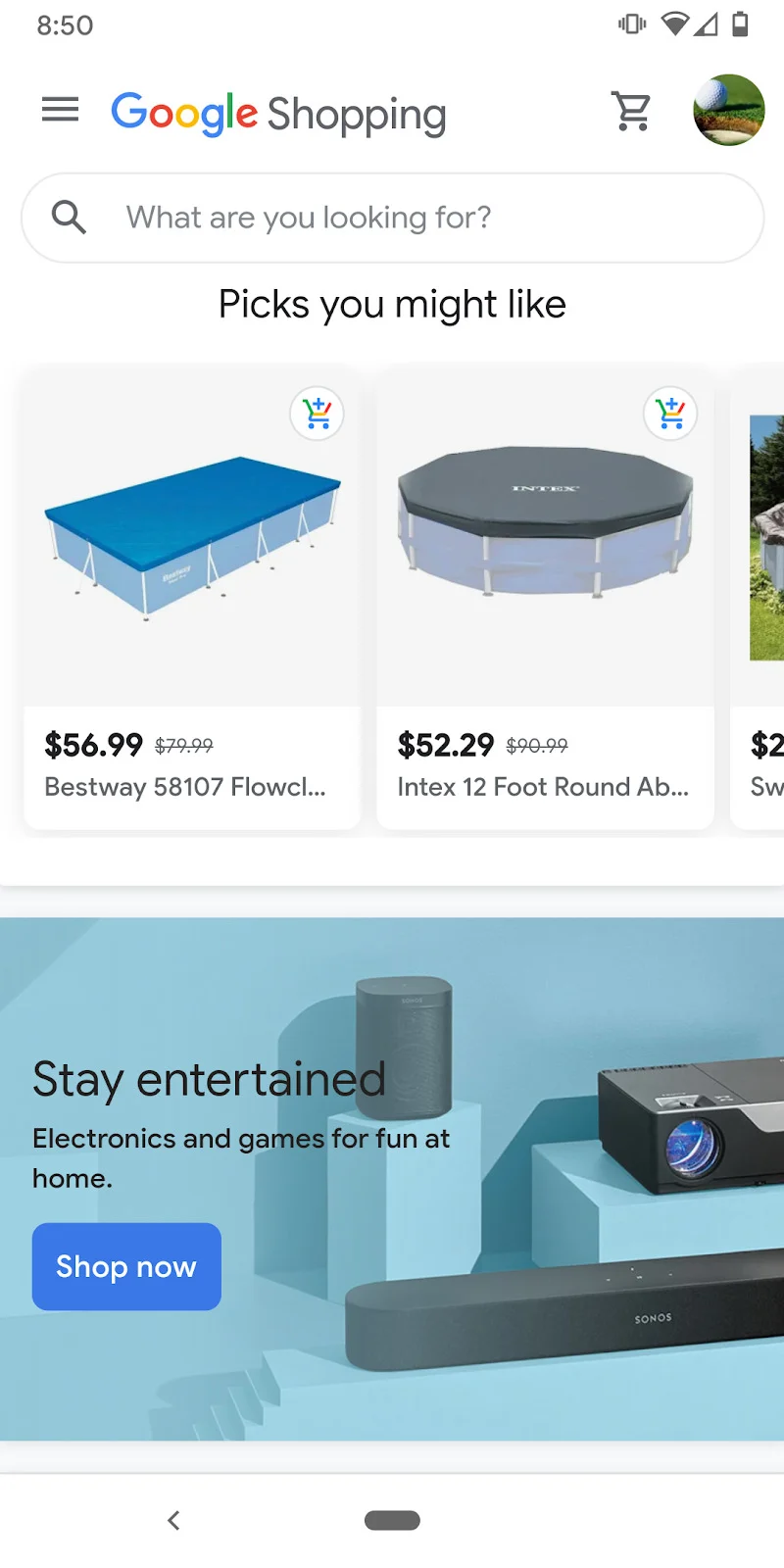
Retailers do not leverage Shopping ads to appear on the New Google Shopping Experience. Instead, they must enable a program within Merchant Center called Shopping Actions. These particular product listings do not direct shoppers back to the store as all the purchasing occurs natively in Google Shopping — this now being known as Buy on Google**.**
Shopping Actions or Buy on Google used to follow a cost-per-sale model where retailers would pay a fee or commission to Google when someone purchases, similar to a marketplace like Amazon.
As of July 23, 2020 Google has done away with the commission fees for those new to the program while those already selling will migrate over a few weeks’ time. Furthermore, there is currently a waitlist period wherein new merchants will no longer be able to onboard to Shopping Actions for some time.
In April 2020, Google announced Free Product Listings in the United States by way of another Merchant Center program called Surfaces across Google.
Accelerated by the impact of the coronavirus pandemic and continued spread of COVID-19, the Shopping tab on Google now consists almost entirely of these Free Product Listings – with some Shopping ads and Buy on Google results peppered in.
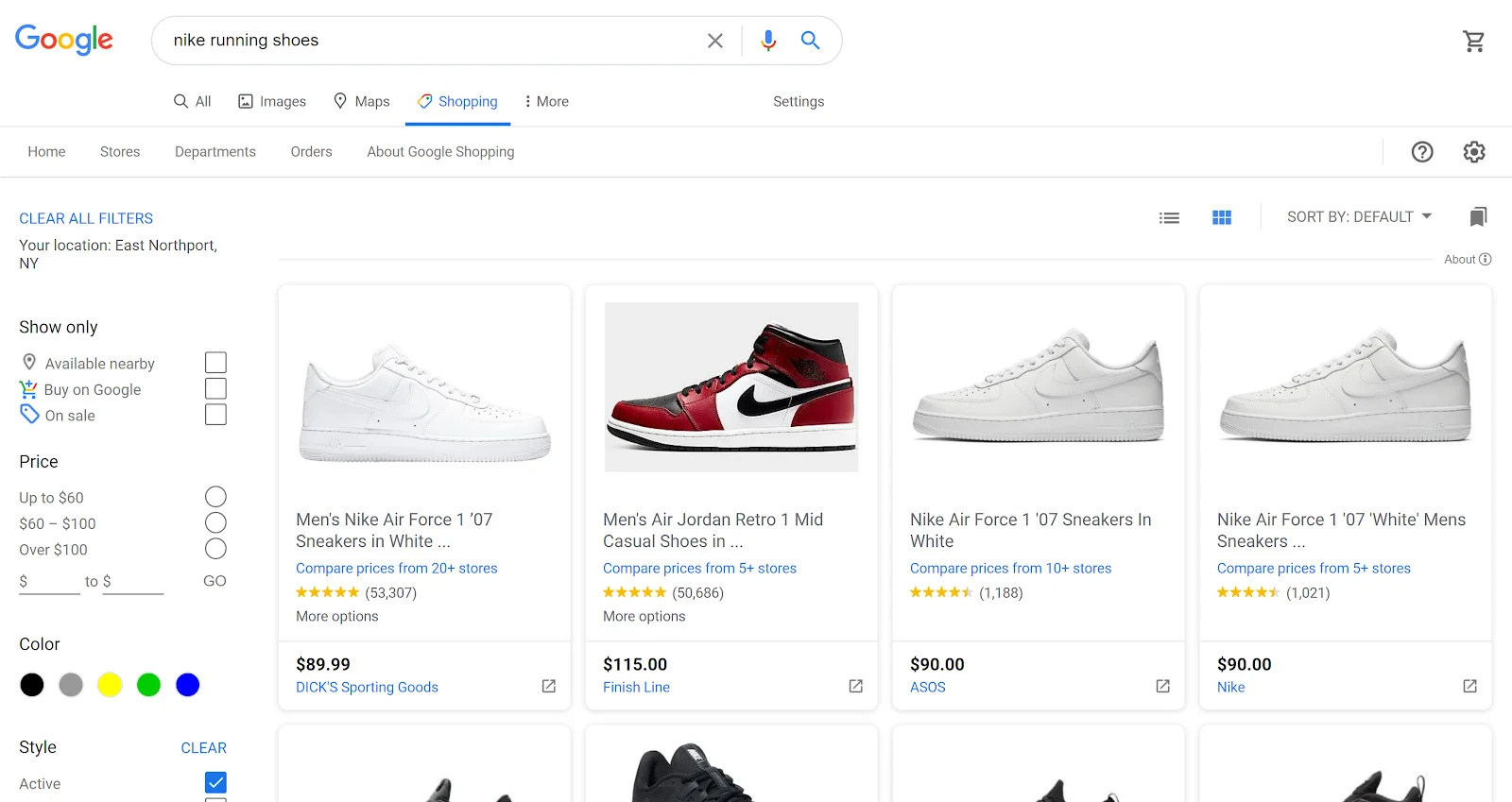
These free listings do in fact direct shoppers back to the ecommerce store and merchants do not pay a fee or a cost per click to get that traffic.
The roll-out of free or organic product listings on Google actually stretches back to February of 2019 and was enhanced again back in January of 2020.
What are Google Shopping ads?
For anyone selling consumer goods online, or even downloadable products, Shopping ads on Google represent one of, if not the most lucrative pay-per-click or search engine marketing opportunity around for ecommerce businesses.
An advertising campaign type within Google Ads, Shopping ads (sometimes still referred to as PLAs or Product Listing Ads) show up across a number of Google’s properties (including Search, Images, even YouTube) and can reach shoppers wherever, and whenever, they’re searching on Google.
Retailers, in most cases at least, pay a fee (aka cost-per-click or CPC**)** when someone clicks on their Shopping ads – this is referred to as bidding**.** Once clicked on, the ad unit directs a potential back to that product’s landing page on one’s ecommerce website.
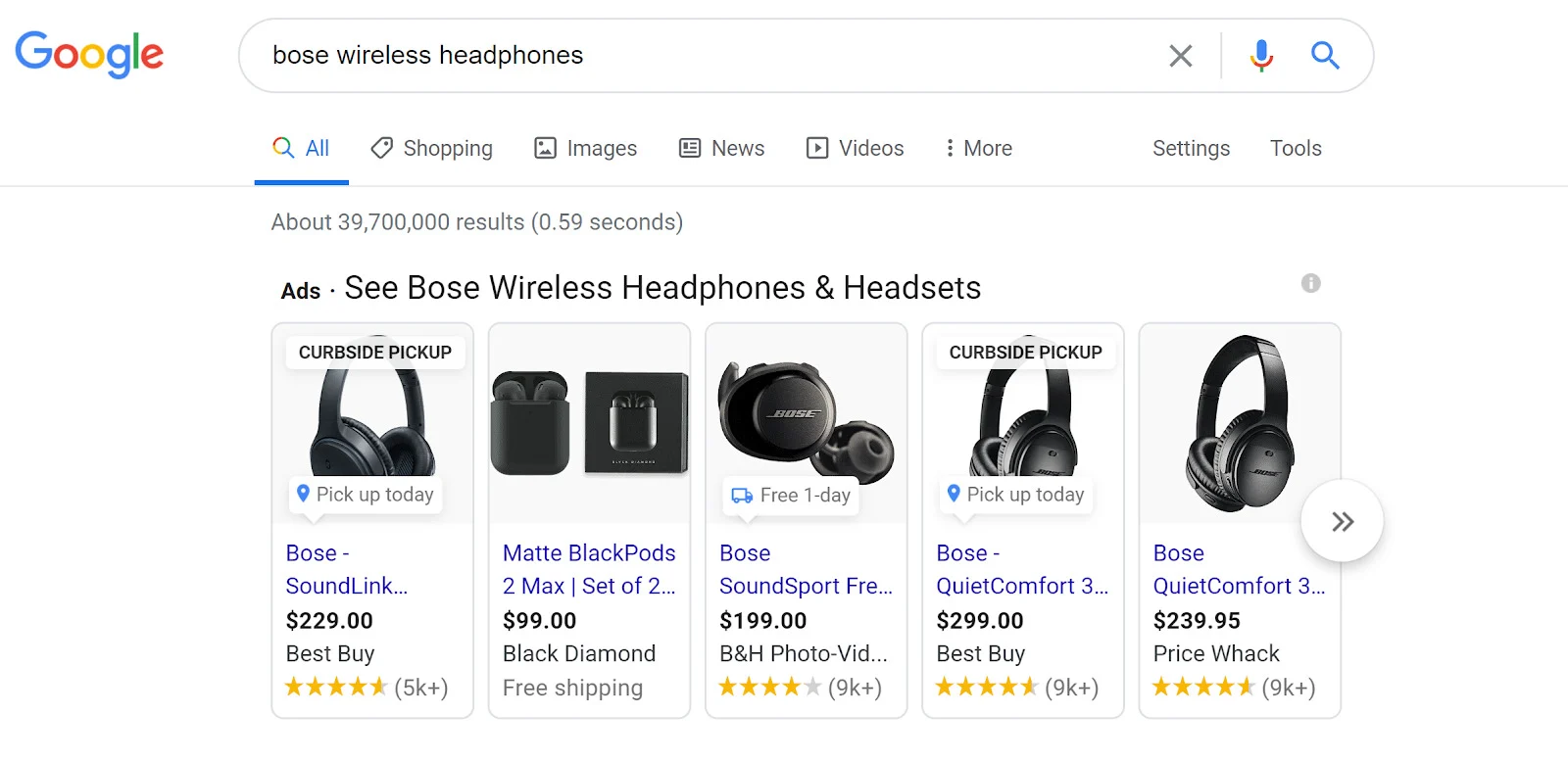
In most cases, Shopping ads appear “above the fold” – before any organic search results and even before Search or Text Ads on Google. These ads display relevant product information to shoppers such as price, seller, and can even show product review stars.
With the launch of Free Product Listings on Google, Shopping ads continue to show less and less on the Shopping tab. This has made it even more important for retailers to take up what digital shelf space is left to continue to drive quality traffic and increase sales for their ecommerce businesses.
As of July, Google has just released free and fast annotations for Google Shopping Ads. This new feature for Shopping ads units highlight not only free shipping on products but also expected delivery and/or arrival times:
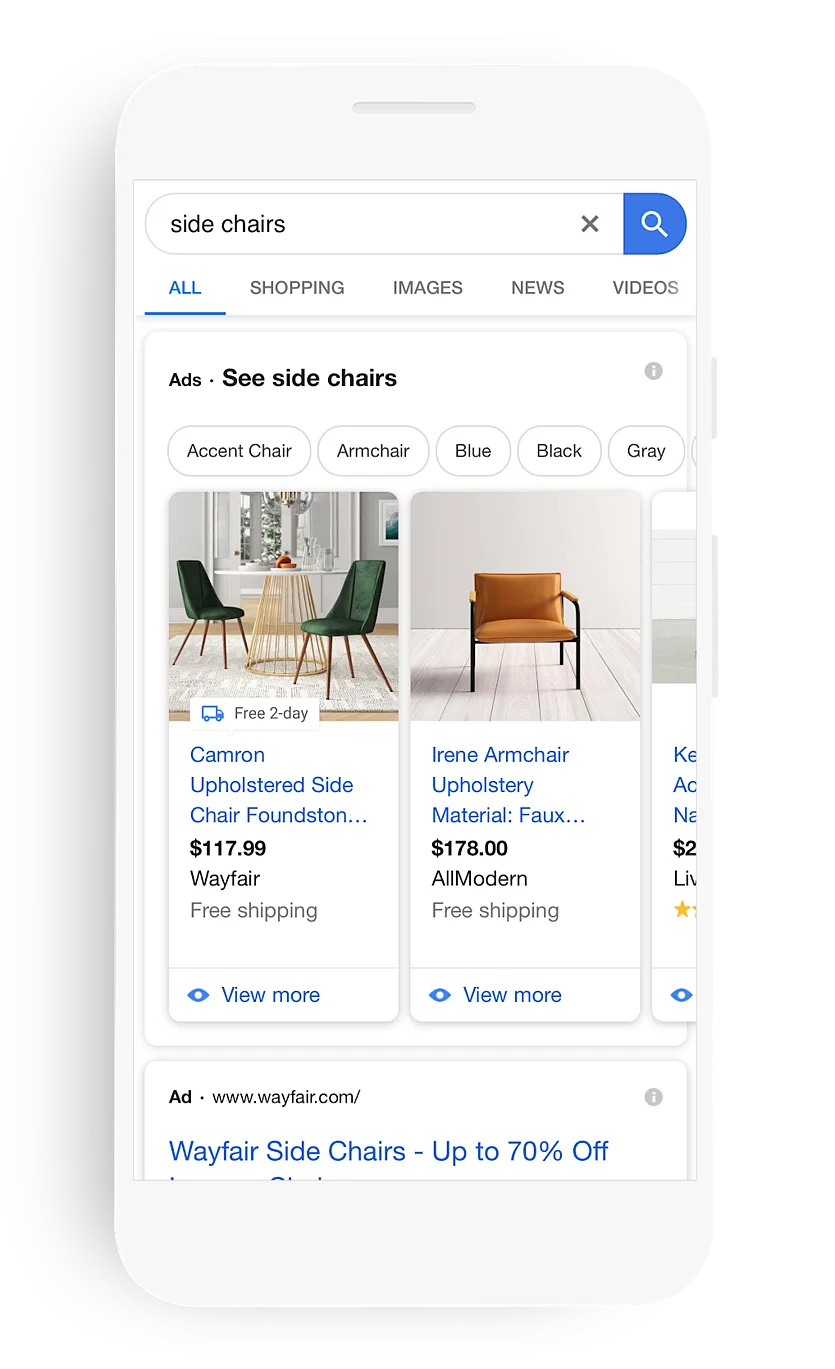
How Does Google Shopping Work?
At the center of all things on Google are keywords or search queries. Anything that appears on Google, be it Shopping ads, Buy on Google, Free Product Listings, or any search result whatsoever is controlled by what people type into the search bar.
In the background, Google’s algorithms try to best match those results with the words typed in by the user.
When it comes to Shopping ads, there is no “bidding” on keywords as with traditional text-based or Search Ads. Instead, retailers and advertisers bid on the actual products themselves to get them to appear in those coveted positions on Google.

Since Shopping Actions (Buy on Google) and Surfaces across Google (Free Product Listings) are not, in any way, a form of advertising, these too do not involve any kind of bidding on keywords.
To be eligible for any of these programs, retailers must submit what is called a Product Feed to Google Merchant Center. This product feed is essentially a catalog of one’s products and product data such as titles and descriptions.
It is that very same product data that Google uses to fuel the results of what a potential shopper types into Google.
Google does use some advertising data to help fuel results produced by Surfaces across Google and those Free Product Listings, but you cannot pay to have these listings appear more frequently or in more prominent positioning.
Google Shopping Can Help Your Ecommerce Store
In all its iterations, Google Shopping is an ideal source for attracting more shoppers – one that can also be both cost-effective, and highly profitable when you know what you are doing.
When it comes to Shopping ads, you are the one that has a bit more control over it though as you can create and manage the campaigns, set your desired budgets, and optimize those campaigns through various means.
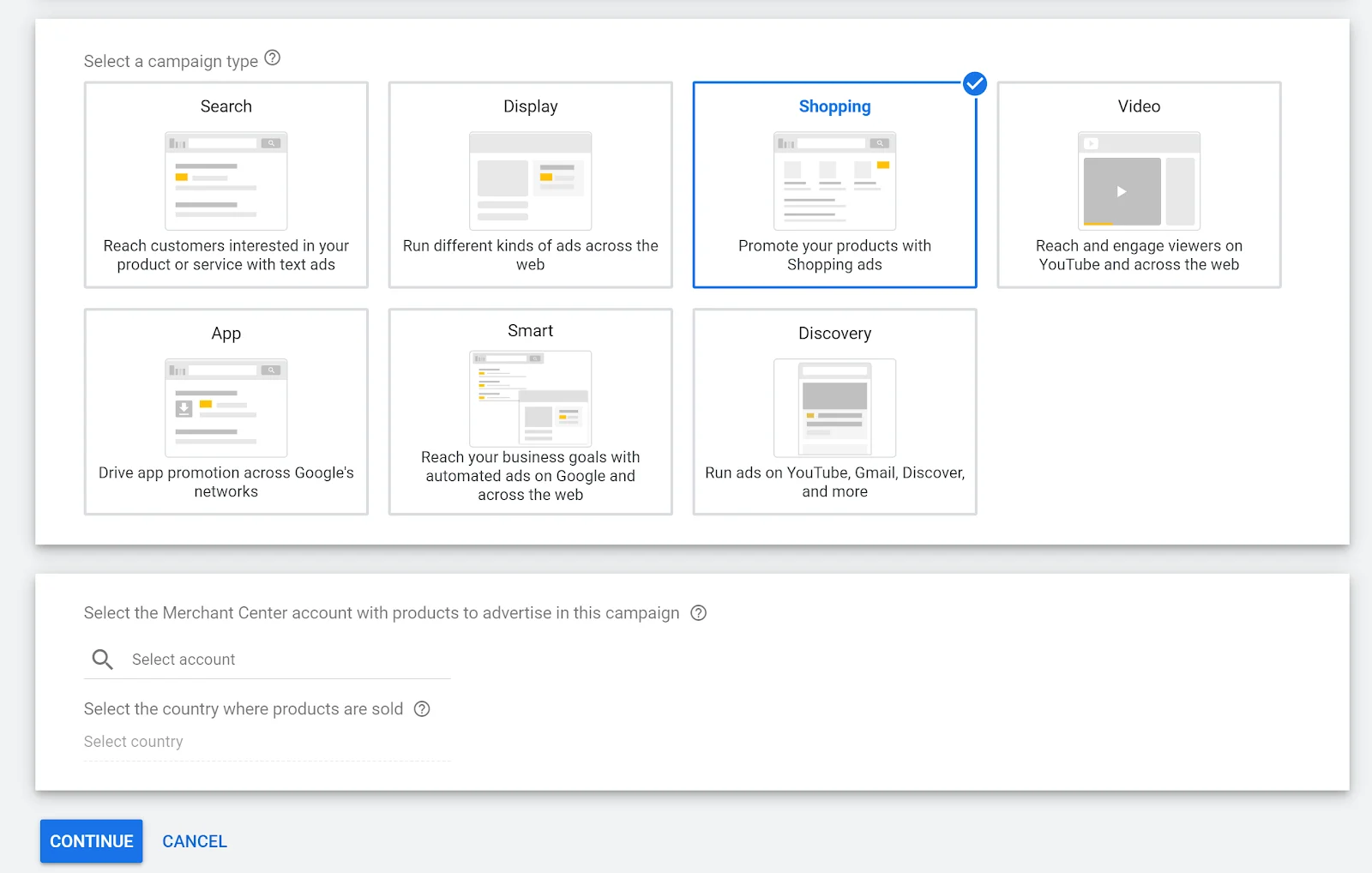
Surfaces across Google and Free Product Listings have become that “icing on the cake” when paired with Shopping ads.
Together, these programs can help grow your store in many ways, but no so more important than:
1. Broader reach.
At a global scale, Google controls over 91% of the search market share making it the #1 search for shoppers looking to buy goods online. Compared to any other shopping destination out there, Google is rivaled only by Amazon as far as where consumers start their purchase journey online.
2. Better qualified leads.
Although there is a tremendous amount of personalization that goes into it (and now more so than ever before), shopping on Google is almost entirely intent-based. The traffic garnered from such things as Shopping ads consists primarily of shoppers who know what they want and want it now.
3. Increase ROI.
When properly managed, Shopping ads specifically have a high probability to be incredibly profitable while programs like Surfaces across Google affords retailers the opportunity to attract shoppers and not pay a single dime when they click on those product listings.
4. Emerging technologies.
When combined (not to mention also with other ad campaign types in Google Ads), these services work together to provide a hyper-targeted way to reach more shippers and boost up sales in many unique ways. Shopping Actions (Buy on Google) specifically allows retailers access to show on emerging surfaces like Google Assistant and reach shoppers on Google Home devices.
It is important to note that programs such as Shopping Actions (Buy on Google) and Surfaces across Google are not widely available at the moment.
However the good news is that Google is working on expanding them both globally over the course of this year and next.
As such, I’d like to emphasize a bit more on Shopping ads and ways that merchants from around the world can create, manage, and optimize successful Shopping campaigns.
Establish Google Shopping Campaign Goals
As with any of your digital marketing or even general ecommerce growth strategies, having the right plan in place is what sets you up for success later down the line.
It is incredibly important to isolate and set the right goals for your particular business. While larger brands will often focus first on broader goals such as increasing traffic, smaller business owners must consider their costs a bit more heavily and thus profitability becomes more important.
Here are a few of the top things to consider:
1. Attract more customers.
What’s most important to remember about this goal is what comes after the purchase. By building a larger audience you are able to not only showcase your brand more widely, but you can also increase Lifetime Value and repeat purchase behavior substantially.
The more traffic you do get from Shopping ads also opens you up to the opportunity to remarket or retarget previous visitors through new campaigns such as Dynamic Remarketing or by adding Audiences to existing Shopping campaigns. Google requires a minimum of 1000 unique visits captured by your remarketing tag to allow for this.
2. Increase sales.
The key word here is revenue. Obviously you need people to buy from you to be able to continue to run your business. However, there is a big difference between wanting to increase sales versus needing to be profitable at the end of the day.
After it’s all said and done, you still must find a way to balance increasing sales with achieving a profitable ROAS or return on ad spend. Larger brands will often put sales ahead of profitability because they have a better understanding of the value of a customer overall and not in that one-off buying situation.
3. Target profitability.
The majority of store owners will want to focus on this especially after they have been running Google Shopping ads for some time. In this, you must key in on some important metrics not only for your ads but also for your products themselves.
Incorporating your margin or cost of goods sold – either at the product level or by using a general average – is the only way to truly determine whether you are making money or losing it. Consider the overall cost of your advertising or Ad Spend, add that with your COGS, and then determine the difference between that number and the revenue generated by your Shopping campaign(s).
With that being said, these are only a small handful of the potential goals you should consider when getting started with Shopping ads on Google.
You should also think about which products you should emphasize more than others. Often referred to as a Top Performers strategy, many smaller to small-medium sized ecommerce businesses will focus far more on their top-selling SKUs rather than put their entire catalog out there and potentially waste precious advertising dollars.
How to Set Up Google Shopping Ads for Your Online Store
If you have yet to get your feet wet with Shopping ads, know that it is a relatively extensive process to get set up, configured, and then simply be eligible to start running them on Google.
There are three key Google products that you really MUST have — Merchant Center, Google Ads, and Google Analytics:
Merchant Center is where your product feed will be sent and stored and also where you will enable programs such as Shopping ads and Surfaces across Google.
Google Ads is where you build and manage your Shopping Ad Campaigns and provides important performance reporting and tools to help optimize your advertising.
Google Analytics is a free tool that helps you track visitors and conversions on your store, and connects to Google Ads to enhance tracking and reporting.
Some may argue that Google Analytics is “optional,” but I 100% disagree. Analytics is a crucial part of the trio.
Important Note: Make sure that you use the same Google or Gmail account to set up all three of the following services.
1. Set up Google Analytics.
Install your Google Analytics Tracking Code: BigCommerce makes it super easy to get your Tracking ID implemented for your store. This is crucial as it allows for the capture of vital performance metrics for your website and your advertising.
Ecommerce Settings: Ecommerce Settings allows Google Analytics to begin tracking vital metrics such as cart-level shopper behavior. By default, it will also produce the Transaction__s Conversion Goal which would then be imported within Google Ads. Enhanced Ecommerce Settings (OPTIONAL) only further improves the depth of data collected, with the optional step of also tagging your checkout-funnel steps. You can locate these in your Analytics account within Admin > View > Ecommerce Settings.
Data Collection & Retention: Also found in Property settings under Tracking Info, these settings are incredibly important. Data Collection now uses Google signals and allows Analytics to collect additional data about your visitors outside of the standardized data when it is not enabled. Data Retention (relatively new and not as important), can be used to govern the amount of time before user-level and event-level data is automatically deleted from Analytics’ servers.
Link your Google Ads Account: If you have a Google Ads account already then take care of this now. This is found under Property settings and under Google Ads linking. If you don’t have Google Ads yet, skip ahead and then come back to finalize this. Without this connection you will not be able to properly track conversions or sales that come from your Google Shopping campaigns, nor will you be able to leverage building Audiences, such as for remarketing, and connecting them with Google Ads.
2. Set up Google Ads.
Create your Account: Google walks you through setting up your Google Ads account for the first time including setting up your billing for advertising and even allowing you to create your very first campaign – which you should pause immediately once you are done.
Set up Conversion Tracking: When you enabled Ecommerce Settings in Google Analytics, you also turned on the Transactions Conversion Goal for Google Ads. While Google Ads Conversion Tracking can also be used, the vast majority of ecommerce business owners will see more accurate conversion value (revenue) reported by the Transactions conversion goal that can only be imported from Google Analytics. In Google Ads navigate to Tools & settings (wrench icon) > Measurement > Conversions. After choosing to add a new Conversion goal, select Import > Google Analytics and then continue on with the steps outlined.
3. Set up Google Merchant Center.
Create your Account: This is also very easy and straightforward. Simply follow the steps outlined in Merchant Center.
Claim & Verify your Website URL: Merchant Center offers a few ways to do this but the easiest way is by adding a simple meta tag to your BigCommerce store. Once added, you can return to Merchant Center to finalize the claiming and verification of your website.
Configure shipping settings: All retailers must have some form of shipping configuration set up for Merchant Center. This tells Google how you ship products and also at what cost. This information is then shared in your Google Shopping ads so consumers are fully aware of what to expect when clicking. You must provide Google with the most accurate shipping information possible. They allow for free or flat rate configurations and even custom configurations or carrier-calculated rates.
Set taxes (US Only): Stores based in the United States only are required to configure tax settings which is also shown in Shopping ads. You can set up specific taxes per each state you charge taxes in, or if you don’t charge taxes then you can set that up as well. For stores outside of the US, it’s important to note that unique taxes such as VAT or GST usually must be added to the price in your product feed.
Link your Google Ads account: If you’re going to run Shopping ads then this is of course an absolute must. By linking Merchant Center and Google Ads, your product data from your feed is brought over to allow you to build your ad campaigns.
I’m going to harp on your shipping and tax settings here for a moment. Google, especially as of late, has been cracking down on websites that do not meet their policies. We recommend using a feed management solution to help maximize your performance and minimize any suspensions.
Should a store not meet these policies, Google will suspend your Merchant Center account, and thus you have to go through a relatively extensive process of them having to tell you why it was suspended, review your account after you have made the required adjustments, and then wait for them to either lift the suspension or come back saying you need to fix more things.
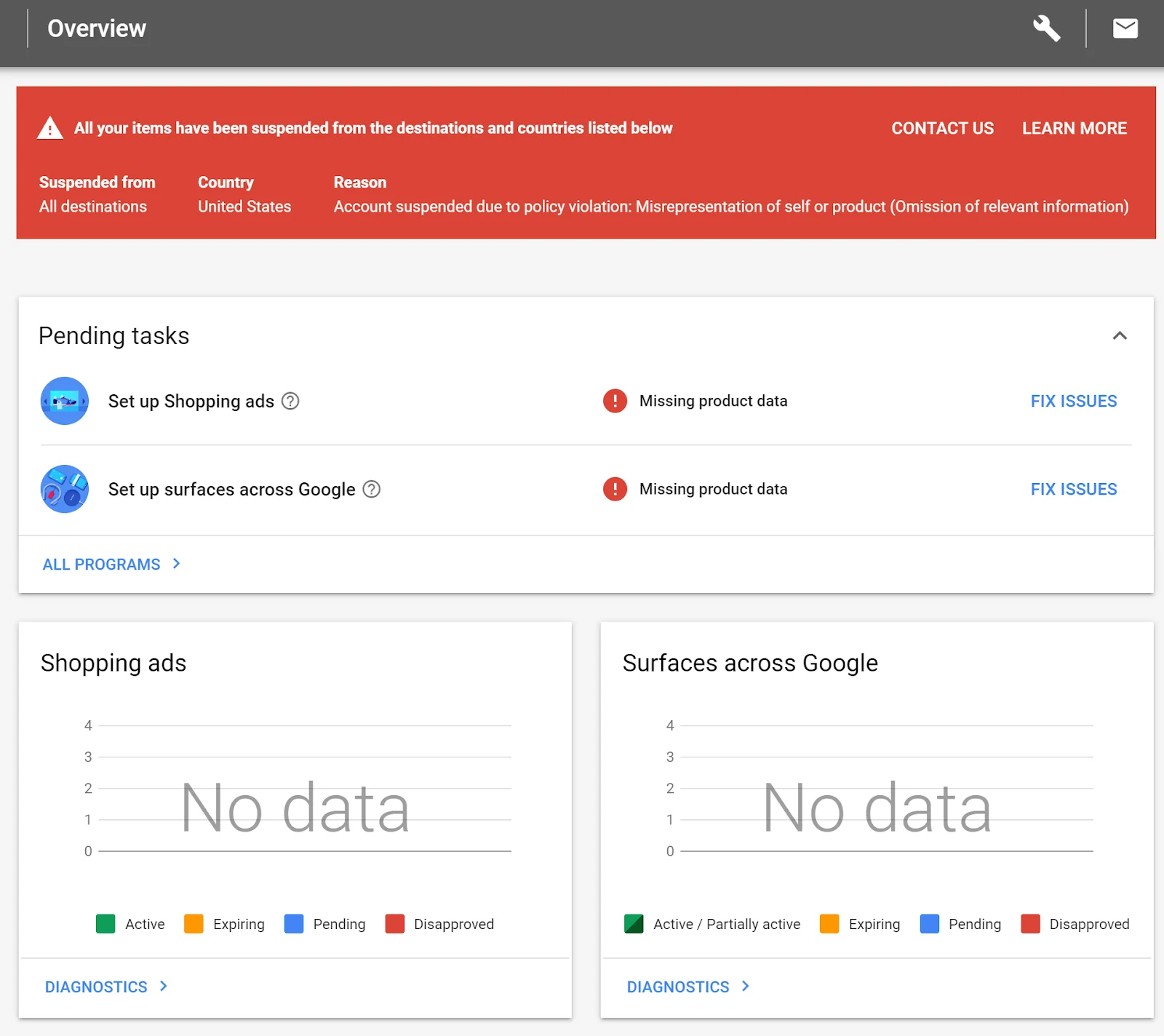
Shipping and tax are required configurations, but NOT having them is NOT grounds for a suspension.
However, if you provide Google with inaccurate or false information for either of these then THAT is something that can get your Merchant Center account suspended.
This happens because Google’s crawlers or bots will quite literally scan your website, go through your website’s add to cart and checkout process, and verify that you meet their policies.
Suspensions occur entirely through automation, but getting them lifted requires human support from Google.
I CANNOT STRESS ENOUGH how important it is to not only first set up this information properly, but also maintain it over time should you ever change how you ship your products, what you charge for shipping, and/or if you tax your shoppers.
Should you feel like any of this is overwhelming, or if you get totally lost along the way, know that there are always dedicated Google Premier Partners who can help you all throughout the journey.
Creating a Product Feed for Google Shopping ads
To recap, a product feed is a catalog of one’s products and product data such as titles, descriptions, images, and other attributes that Google requires you to submit to Merchant Center to be eligible to run Shopping ads and other programs such as Surfaces across Google and Shopping Actions.
Product data is what, again, fuels your Shopping ads so that they may appear in the search results when people type keywords or search queries into the search bar.
There is an exhaustive list, known as Google’s Product Feed Specifications, of both required and optional attributes to include in your product feed per each individual product within. Learn more about Google Merchant Center product data specs from Feedonomics.
For select product types, retailers must submit even more data than others – this can be seen in Apparel & Accessories.
Google accepts product feeds submitted in a couple of different formats. For years, retailers had to build and maintain massive TXT, XML, or even Google Sheets files (just to name a few) that contained all the required and optional attributes.
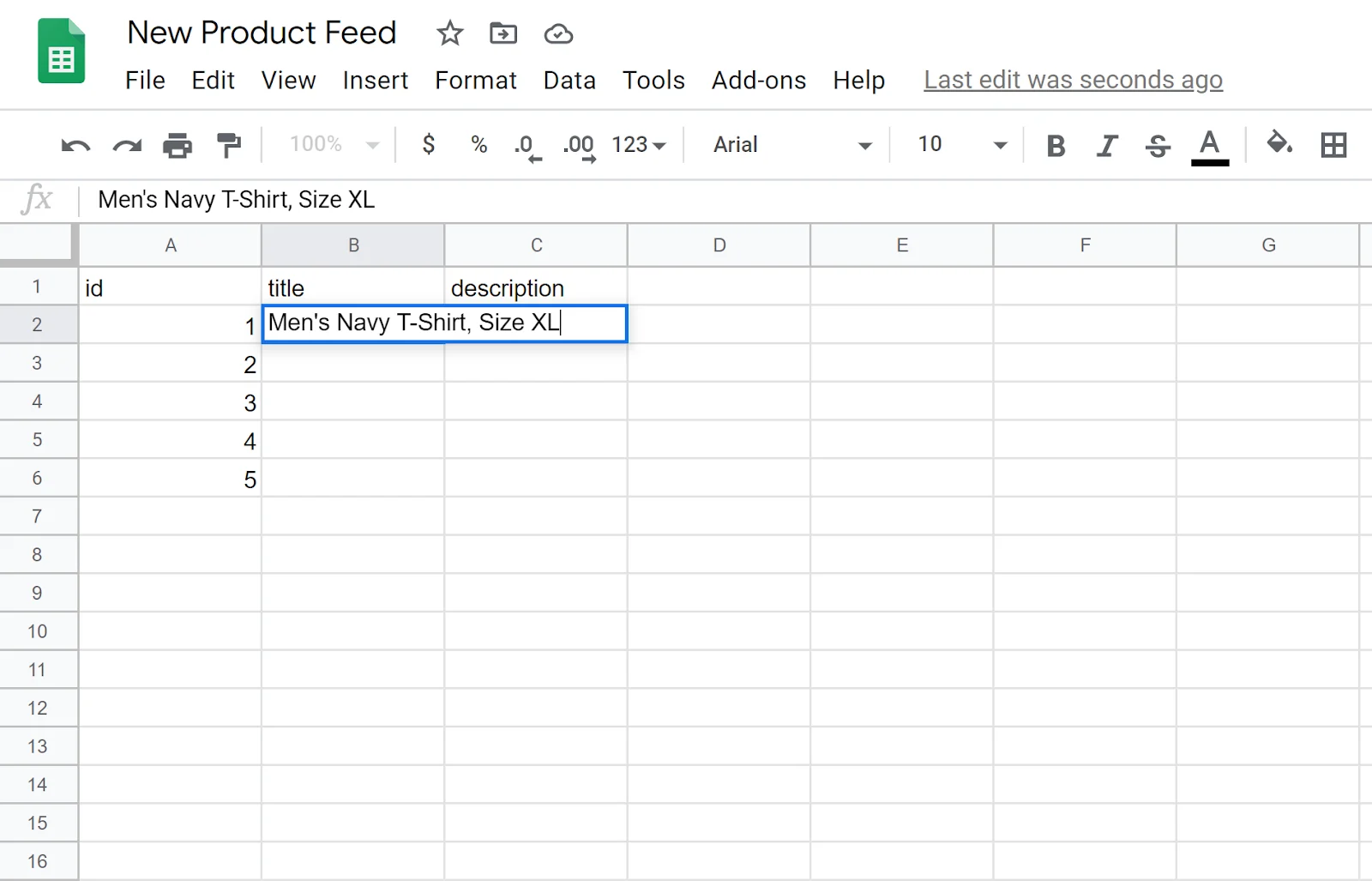
However, nowadays most ecommerce platforms, including BigCommerce, have fully integrated solutions for product feeds that automate the import of that product data, configuration of the feed via Google’s Content API (Application Programming Interface), and constant maintenance of data flow between one’s store and Google Merchant Center.
Smaller stores with fewer products may not necessarily need such solutions, although it is highly recommended that stores of any shape or size take advantage of them.
As such, if you were to go it on your own, I typically recommend using Google Sheets to build and populate your product feed.
Here’s just a few of the key product attributes to be aware of:
1. Product ID.
How Google identifies your products in not only Merchant Center but also in Google Ads and Analytics as well. Each product is required to have a unique ID assigned to it in your feed.
2. Product title.
The most important attribute for any product, product titles are what Google uses to match shopper search queries to your products and have them appear in the search results. Also required for all products in your feed.
3. Product description.
The second most important attribute, descriptions are another place Google draws from for keyword density. It is a general best practice to “front-load” your most valuable key terms from your product title and into your descriptions.
4. Google Product Category.
No longer required by Google, but it’s important to note that if you do note provide one then Google will now assign one automatically for any product. GPC follows Google’s product taxonomy.
5. Product type.
An often misunderstood attribute, Product type is actually a user-defined value that you have control over. It is often considered the third-most important attribute for keyword density after titles and descriptions.
6. Product photos.
Submitted in your feed using the URL where a particular product image is housed, product photos are a vital aspect of your feeds and Shopping ads. Google will actually reject or disapprove a product should its image be poor or not meet their requirements.
7. Availability and Condition.
These required attributes go hand-in-hand and their values are set forth by Google thus you must submit specifically In Stock, Out of Stock, or Preorder for Availability, and either New, Used, or Refurbished for Condition.
When you are ready to submit your feed to Google:
Log into Merchant Center.
Navigate to Feeds in the main navigation.
Click on the big blue + icon.
Set your Country of sale, Language, and Destination(s)
Destination will be the specific program, such as Shopping ads, that the feed is intended for.
Name your feed.
Select the input method (ie Google Sheets) to submit your feed in.
Click CONTINUE and follow along with Google to finalize the upload.
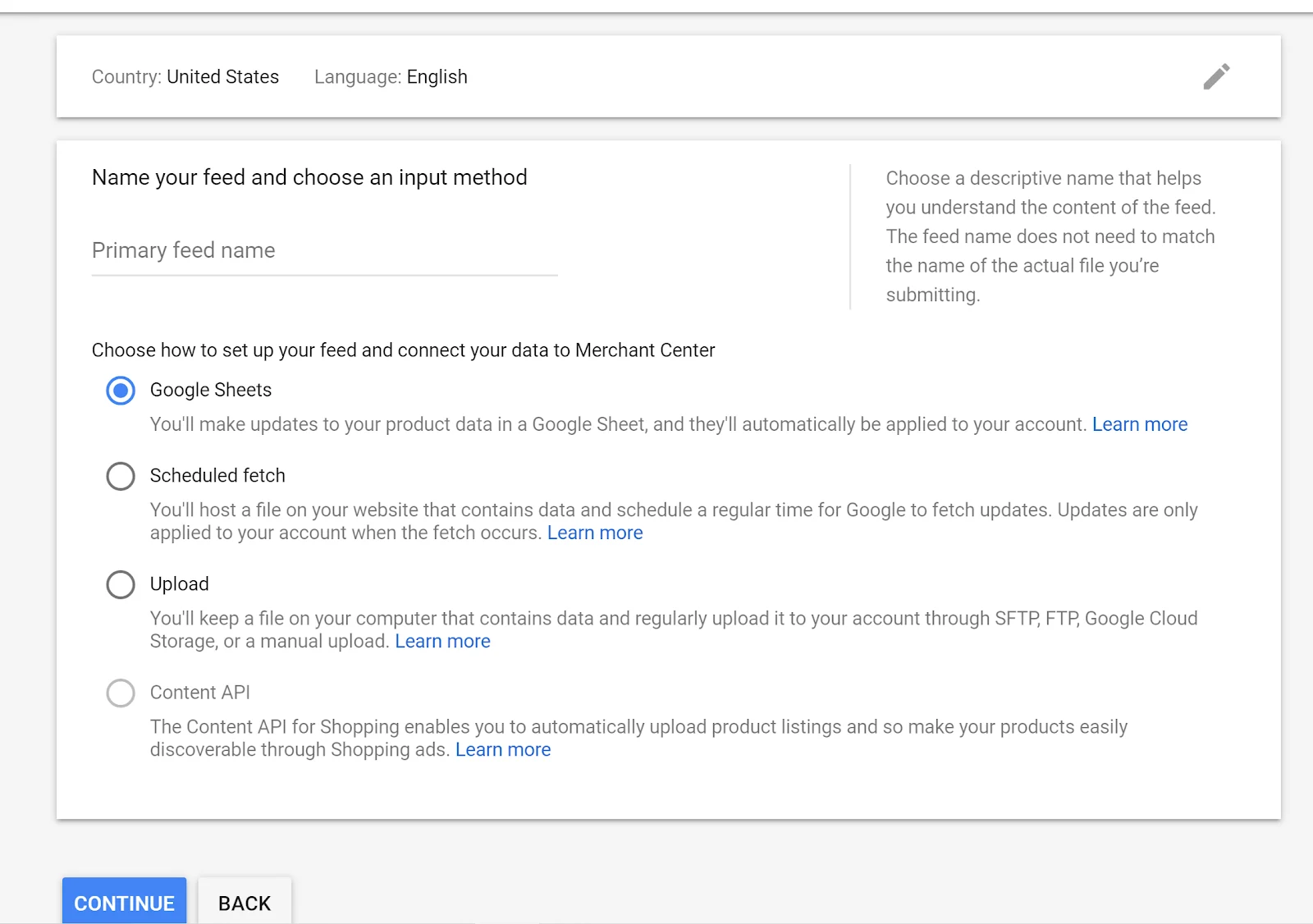
Once a feed is submitted for the first time, Google goes through an average 3 to 5 day process during which it reviews your feed and product data, scans and crawls your website and product images, and aggregates feed diagnostics and product data error reports. Afterwards, Google will either approve or disapprove products for a given program such as Shopping ads.
Approved products are eligible to begin running ads for while disapproved products typically mean that you may:
Be missing required product data.
Have misconfigured or improperly formatted product attributes.
Have certain products that Google restricts or forbids advertising on and are subsequently rejected for “Violation of Shopping ads policies”.
You’ll now be tasked with sifting through the error reporting and diagnostics found within Merchant Center and making the required changes to get products approved.

With whatever products are approved, it’s time to start setting up your first Shopping campaign in Google Ads!
Develop Your Google Shopping Campaign
Now, to say that Google Ads can be a bit overwhelming is a vast understatement. I’ve been working with Google Ads for over 10 years now (back when it was called AdWords) and, at times, still find myself stumbling on things that I was not previously aware of.
Google has done an incredible job, however, in making it relatively easy for even total newcomers to get various campaign types set up and configured to start serving ads.
It’s important to note though that while it’s not all that hard to set up a Shopping campaign, configuring and structuring the campaign can get a bit tricky.
To get started, log into Google Ads and navigate to campaigns. Click the large blue + icon here and select New campaign:
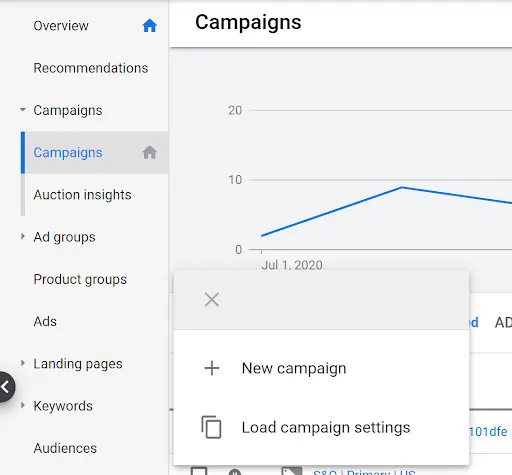
In the next section, for now I recommend creating a campaign without a goal**,** and then selecting Shopping:
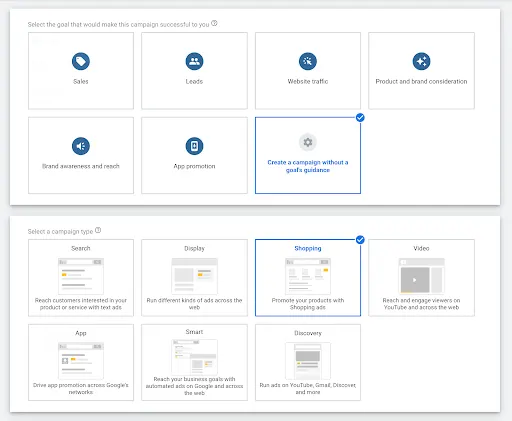
With your Merchant Center account linked already, select it in the field provided. You’ll have the option of choosing between a Smart Shopping campaign or a Standard Shopping campaign:
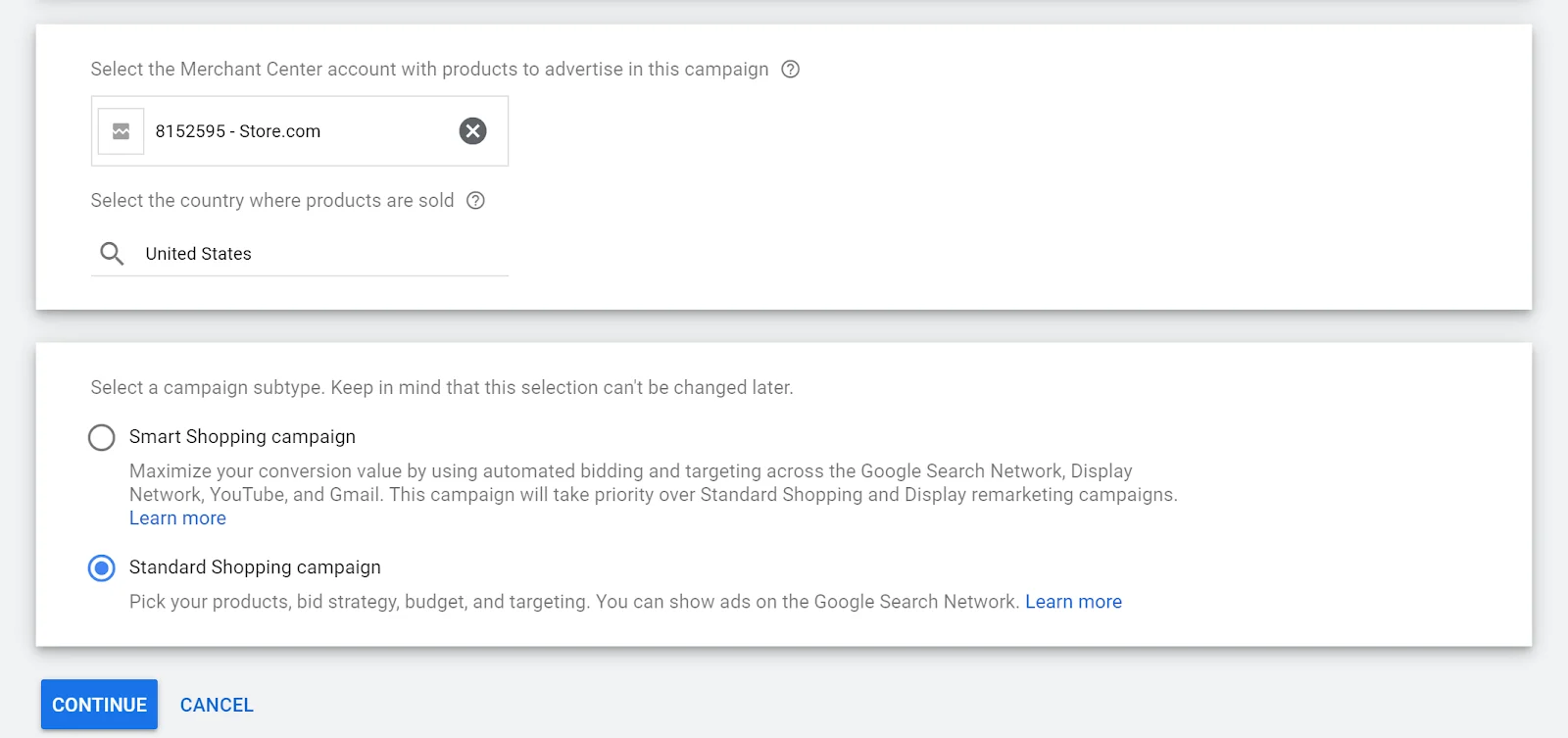
For now, just stick to a Standard Shopping campaign. We’ll be covering Smart Shopping later on. Click CONTINUE once you’re all set.
Next up is your general campaign settings, and there are some very important things to note here:
Name your campaign in a way that makes it easily identifiable to you or your team/staff.
When it comes to Bidding and bid strategy, you can choose to set your own CPC’s manually or opt for any of Google’s Smart Bidding options. For beginners, stick to Manual CPC and be sure to disable Enhanced CPC.
Budget is the total amount you’ll spend in a given day on your entire campaign. Do note, however, that Google can spend a bit more than your daily budget but never exceed the expected total in a given 30-day period.
Campaign priority is often one of more confusing elements for new Shopping campaign advertisers and is broken down into 3 levels: Low, Medium, and High. Essentially, when running more than 1 Shopping campaign at a time, this setting tells Google which of those campaigns should expense it’s budget first before any others. A High priority Shopping campaign, for example, will always run first before either a Medium or Low.
If this is your very first or maybe the only Shopping campaign you plan to set up, then the Campaign priority isn’t something to be all too concerned with. Set it to Medium just for simplicity’s sake.
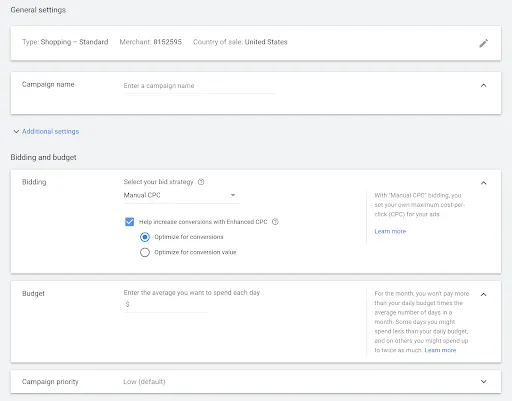
Next up we have our Targeting settings. Things can get a bit tricky here once again but I’ll do my best to help you along:
Networks essentially enable your ads to appear on other Google properties. For beginners I would typically always recommend the Search Network, but not YouTube, Discover, and Gmail. This is because having this Network enabled can cause you to spend your daily budget more quickly which may not be a good way to start, especially those under budget constraints.
Devices, in this section, is typically defaulted to allow display of ads on all devices. Currently Google supports ad display on Computers, Tablets, Mobile phones, and even TV screens. After a campaign has been created, you can modify these through bid adjustments.
Locations is pretty obvious but it’s the territories that you wish to either include or even exclude in the display of your Shopping ads. You can get very specific with Location targeting and optimization or keep it super broad such as targeting an entire country. It is important, however, to be aware of your limitations in fulfillment. If you cannot ship products to a particular region, then you shouldn’t be advertising there.
Start and end dates can generally be ignored as you can very easily (and quickly) pause campaigns from running at any time.
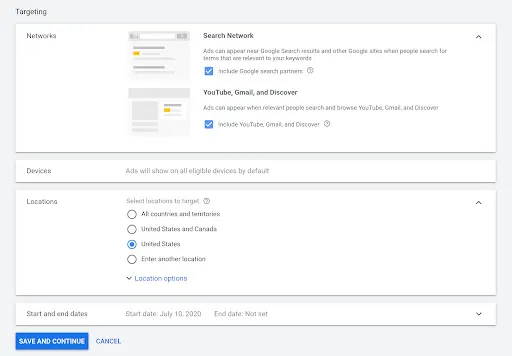
Once you are ready, click SAVE AND CONTINUE to finish up here.
Create Google Shopping Campaign Ad Groups
With your base campaign settings now configured, it’s time to set up your first ad group. Ad groups in Google Ads are essentially structuring elements that allow you to separate key aspects of your campaigns into unique parts.
In Shopping campaigns, for example, ad groups allow you to separate specific sets of different products together.
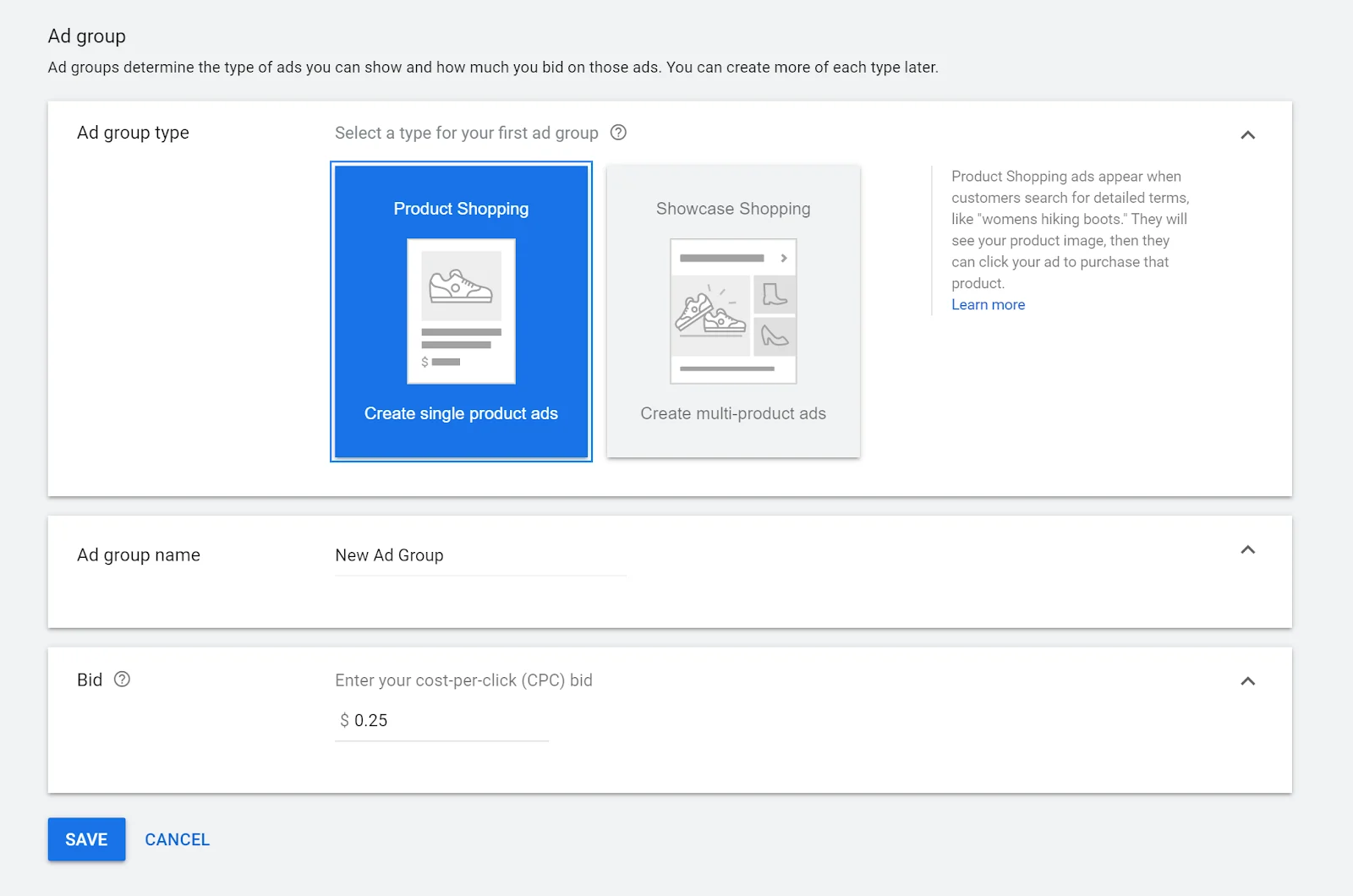
This then allows you to manage and optimize these groups differently based on your desired goals or characteristics of those products.
Specific to Shopping campaigns, there are two types of potential ad groups you can build:
1. Product Shopping.
What is most commonly used amongst all retailers, Product Shopping ad groups produce the singular PLA units that you see most often on Google. This is the ad group type that I’d recommend you get started with.
2. Showcase Shopping.
Lets you group together related products and present them together to introduce your brand or business. Only available in 20 countries, including the US, UK, and Australia, Showcase Shopping ads are relatively new to the game and require a few more parts to get set up properly. I do not typically recommend starting with these but you may certainly add them in later and test them out for your business.
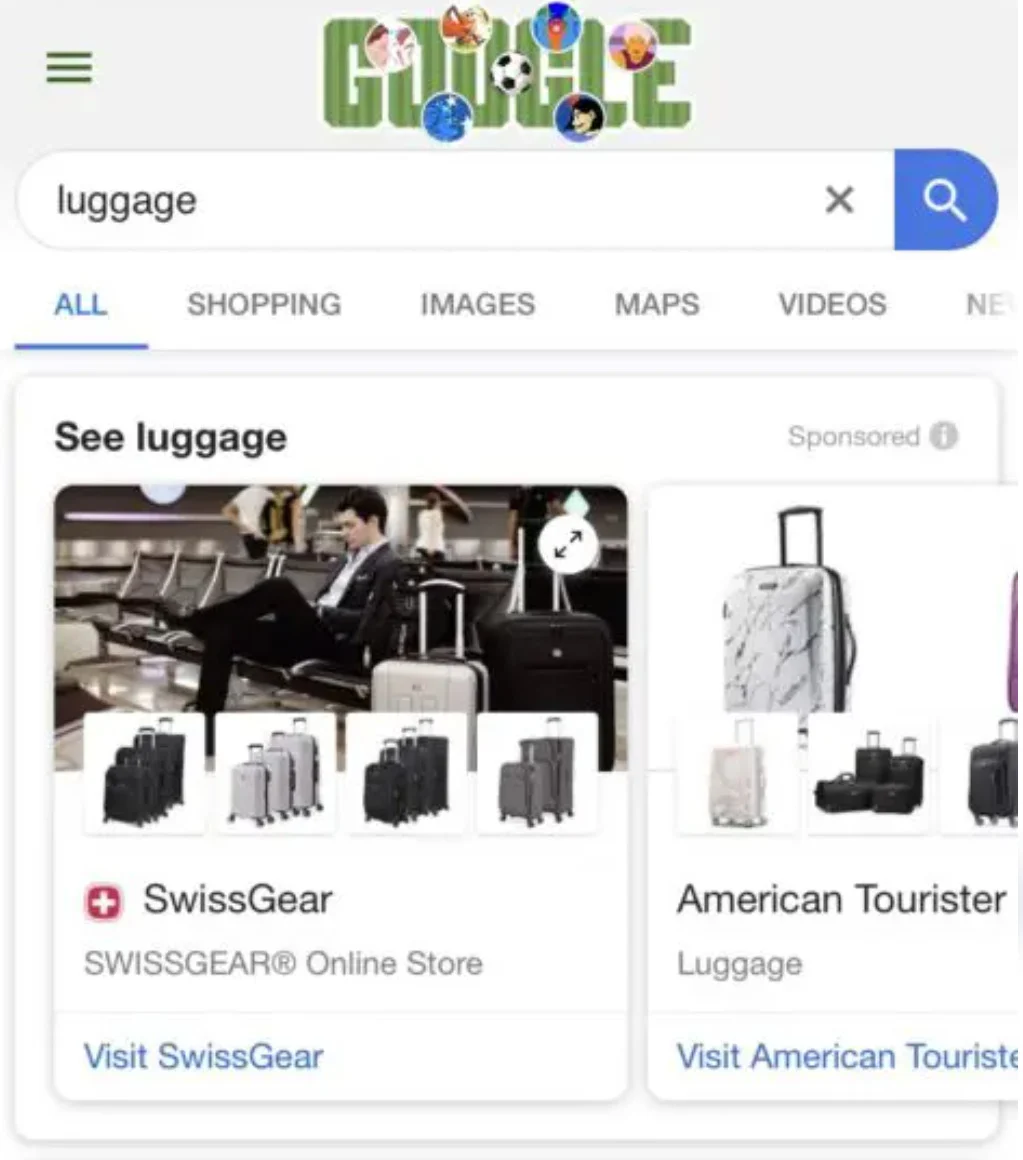
With all that being said, name your first Ad group, and set your Bid. This default bid or Max CPC you set here will set all products within this ad group to spend that amount for clicks on your Shopping ads.
Click SAVE when you’re all done.
HURRAY! You just created your first Google Shopping campaign – sort of.
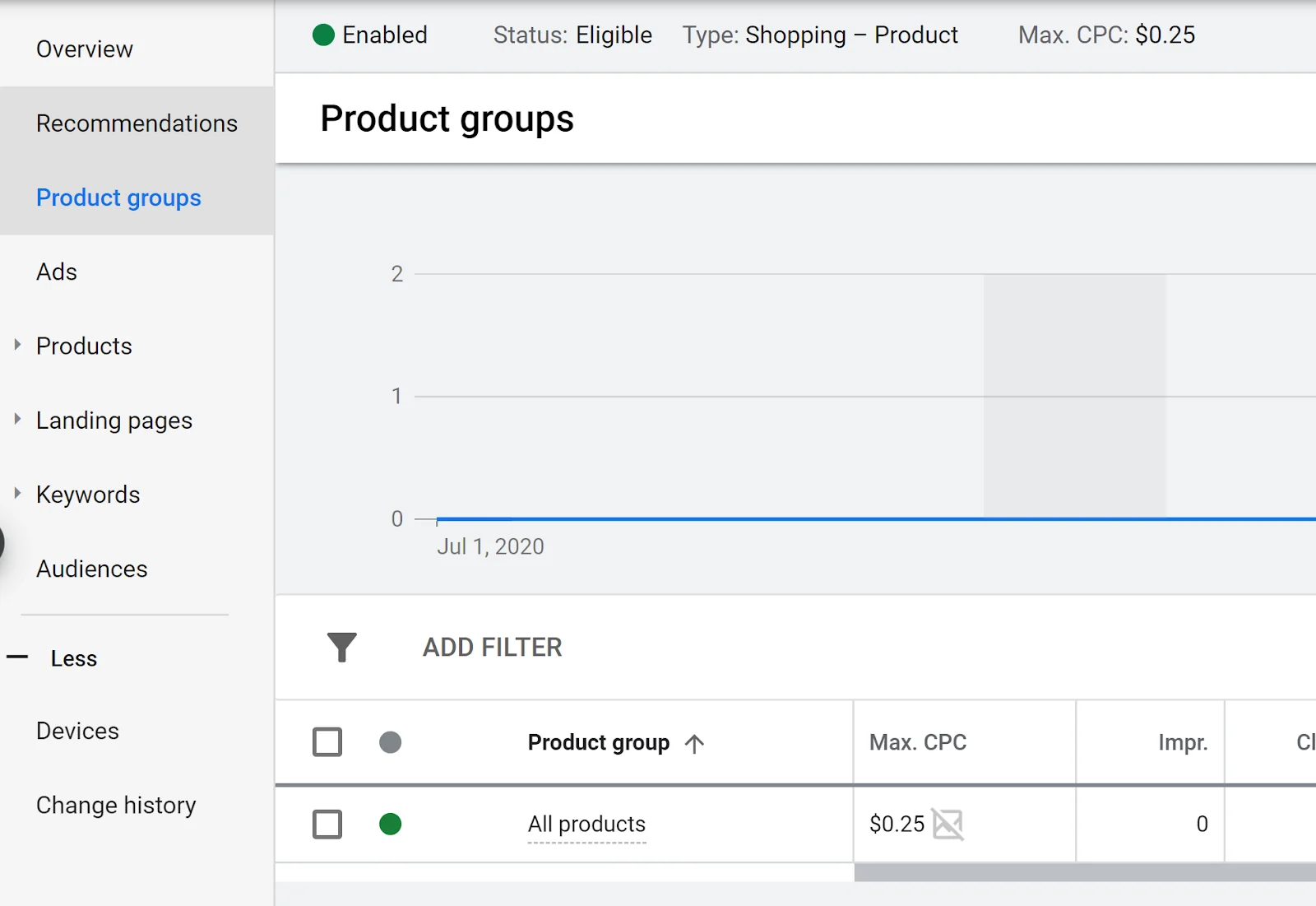
While the foundation has been laid for you to get started, there are still a number of important steps to take to ensure greater success in your advertising efforts.
Google Shopping Campaign Best Practices
Creating your first Shopping campaign is just the very beginning of what I hope will be a very lucrative avenue for you to grow your ecommerce business.
Now comes the time to start focusing on both efficiently managing your campaign and optimizing to achieve greater results over time.
Aside from select, cornerstone elements of successful Shopping campaign management, such as bidding optimization, a few of the other major things to consider include:
1. Create a strong campaign structure.
We left off at a Shopping campaign that basically had no structure to it. It was one campaign with one ad group, and every product held within what is called a Product group. Could you continue to run a campaign like this? Yes. Is it the best idea? Absolutely not.
Ultimately, you want to be able to achieve some level or, even better, the deepest level of granularity possible in your campaign structure. With that, you can take this “All products” Product group and break it down even further using a process called subdivision.
The goal here is to get the structure down to a point that is not only manageable but also affords you the ability to truly understand the performance of your campaign at the product level.
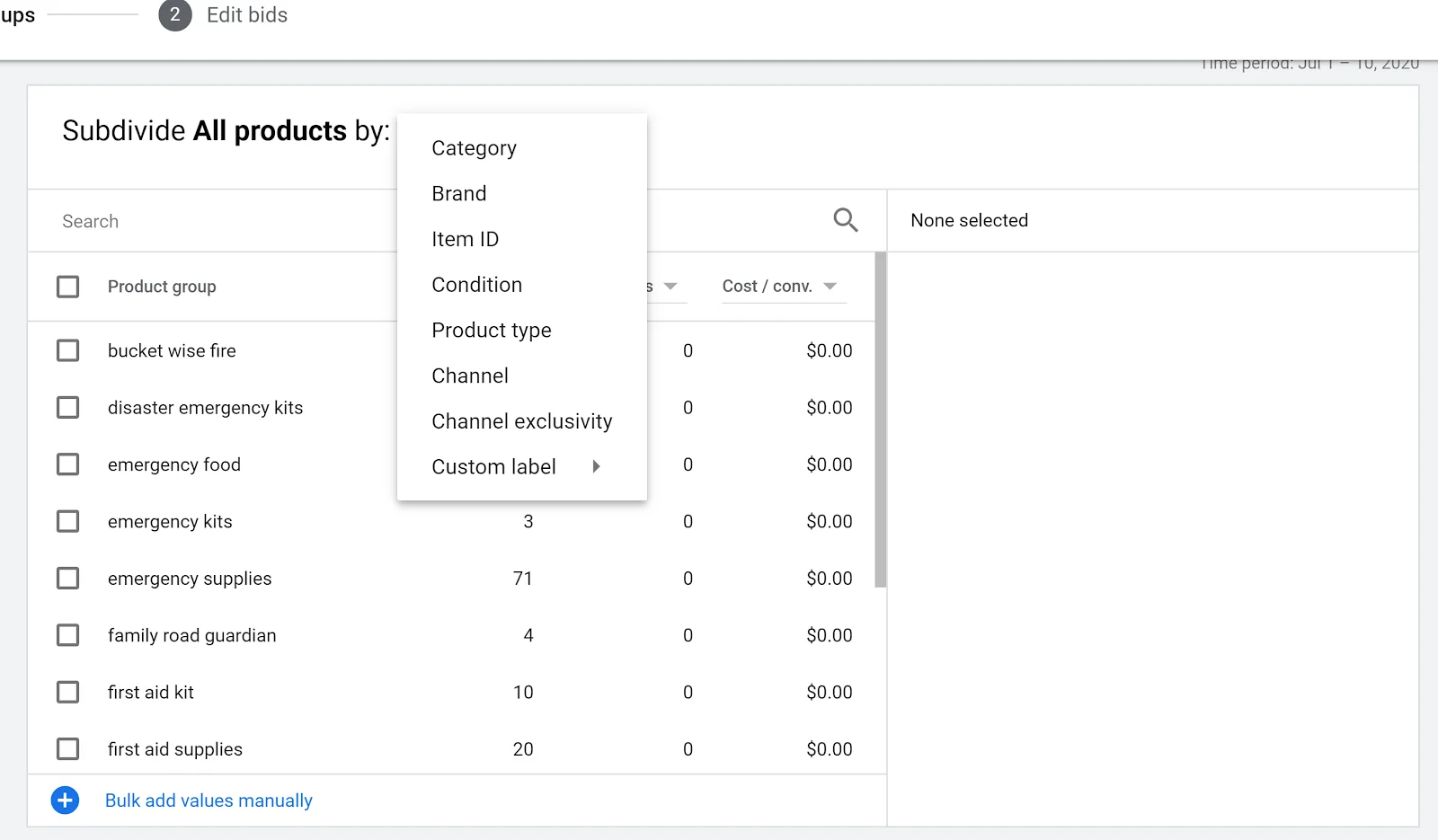
2. Optimize product titles.
You might remember me saying that product titles are the “most important” attribute in your product feed. That was for good reason. By optimizing your product titles, you can give your Shopping ads a far greater chance to appear in the search results for the specific keywords used by potential shoppers.
The better optimized the data, the more likely your ad can appear in prominent positioning. Here’s some product title structure tips for different verticals to get you started:

3. Negative keywords.
If keywords are what cause your ads to show, then negative keywords are what STOP them from showing. Negative keywords are an incredibly important aspect of optimizing your Shopping campaigns to increase profitability.
Though there are general negative keyword lists that are typically recommended by search engine marketers, finding new negative keywords over time takes a bit of time and effort in data mining Google Ads.
By using the Search terms report and filters in Google Ads, you can isolate any keywords shoppers used that DID NOT lead to a purchase, and add them as negative keywords. I highly recommend you get to know keyword match types for Google Ads before you start adding them to your Shopping campaigns.

4. Device optimization.
If you remember when we built our Shopping campaign I briefly mentioned how you could go back and optimize your device settings afterwards. Well, here we are! Optimizing your device setting or device-level bid adjustments for your Shopping campaigns is also an incredibly valuable aspect of improving overall performance both early on and over time.
Device-level bid adjustments let you control how much, or how little, you wish to spend on ensuring ads appear across select devices. Essentially, whatever the default bid or product-level bid is set to, you can broadly modify that bid by a set percentage.
For example, if you do not wish to have your ads appear on mobile devices, you can set the Mobile bid adjustment to -100% (see image below).
Now, you may be asking: Why would I want to do this? Well, it could be for a number of reasons. Using this -100% mobile bid adjustment as an example, maybe this retailer’s mobile site is just not optimized enough for checkout and they often don’t see many sales as a result.
By leveraging a bid adjustment, they can ensure that their daily budget goes entirely to devices that see quality traffic and profitable revenue, as opposed to wasting it.
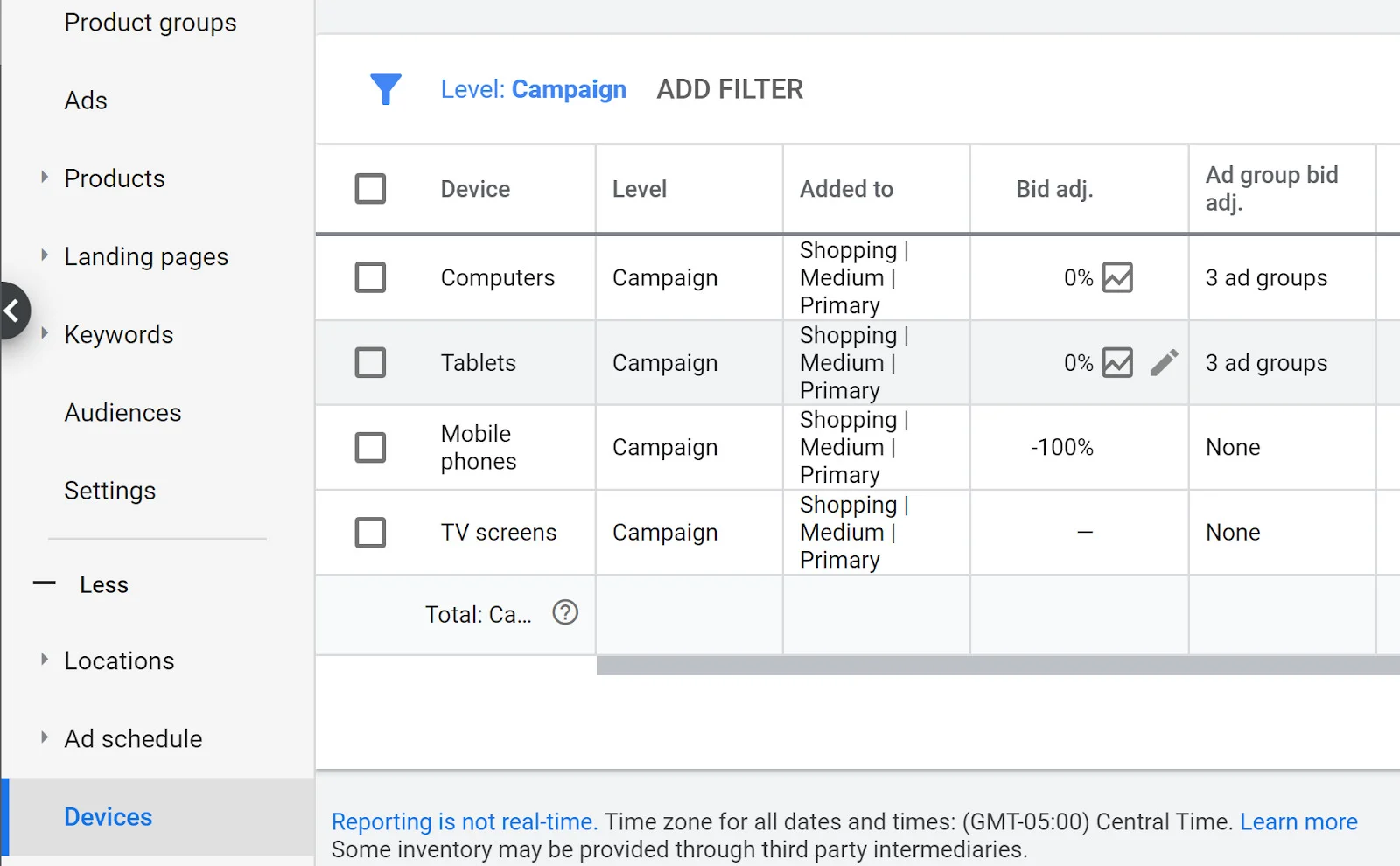
5. Remarketing.
Remarketing, in its broad definition, allows you to retarget previous visitors to your website and re-deliver ads to them after they leave. Back when you were setting up your Google Analytics account, I had you enable Data Collection & Retention settings — and Remarketing is the reason why.
What’s really cool about Remarketing for Shopping ads is that Google allows you to custom-tailor specific Audiences that you then “add to your campaigns” — such as Cart Abandoners — then, let’s say someone clicked on one of your Shopping ads, came to your site, and left without purchasing anything.
When that person goes back onto Google and searches again, your Shopping ads stand a better chance to appear AGAIN, potentially enticing that person to come back and finalize their purchase.
Remarketing is also cost-effective and generally has a high ROI or ROAS compared to direct-click ad experiences, sometimes as much as 50% or more LESS expensive to get someone to visit your store again.
Just as with device-level bid adjustments, you can set bid adjustments for Audiences in Google Ads, affording you a level of control over how much you spend to drive previous visitors back to your website.
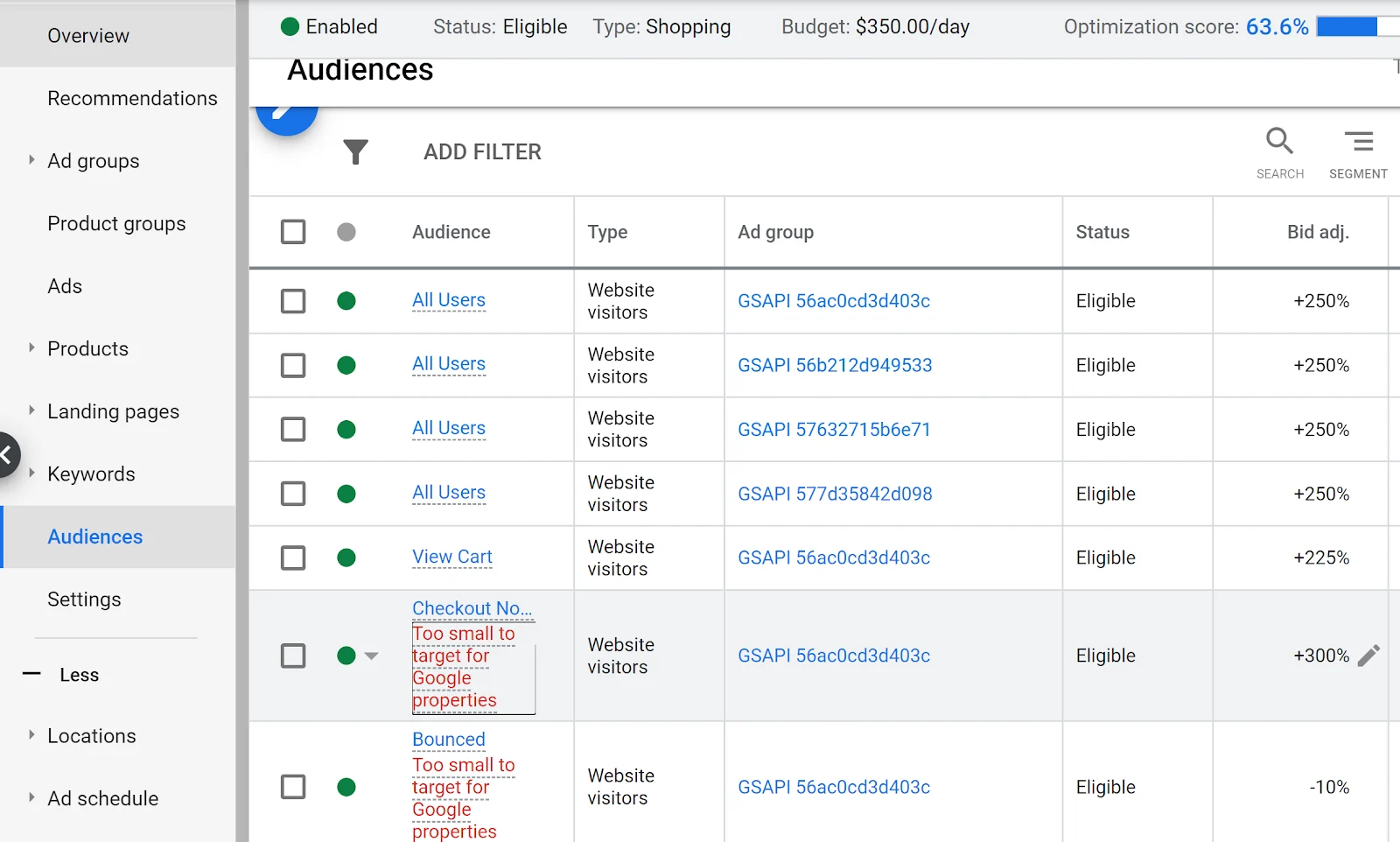
I do want to emphasize that running and even optimizing Shopping campaigns alone is not going to necessarily bring you earth-shattering results.
A lot of work still must go into onsite experience and customer service. You can appear in the best ad positions, drive the most traffic you can, but if consumers are met with a less than desirable experience after the fact then your advertising (namely your advertising spend) would be all for not.
My sincerest hope is that I am at least giving you the tools and a good head start towards success with your Shopping campaigns.
Google Smart Shopping Campaigns
Using Google’s Machine Learning, Smart Shopping Campaigns aim to maximize your potential conversion value by automating bids and targeting across products and audiences.

Your products can show across the Shopping results, on the Display Network, on YouTube, and in Gmail. This campaign will take priority over standard Shopping and display remarketing campaigns.
Essentially, Smart Shopping is “100% autopilot mode” for running Shopping ads.
In tests we have run with Smart Shopping they have shown great promise in both reducing wasteful spend and increasing ROAS. There are some important things to note about them however:
Budgeting: We found that the minimum daily budget threshold to achieve measurable results was no less than $20. While you may attempt to run Smart Shopping with less it is not recommended.
Learning Phase: All Smart campaigns in Google, including Smart Shopping, start off in a 15 day “Learning Phase” where Google’s machine learning adapts to begin delivering ads. During this time ads may not serve and the phase can interrupt other Shopping campaigns from running.
Smart Bidding: In Smart Shopping campaigns you do not manage CPC bids on products. Instead, you rely on Google’s various automated or Smart Bidding strategies to handle all bid changes. The most commonly used is Target ROAS wherein you tell Google a percent value in Return on Ad Spend you wish to have it try and achieve.
Targeting: This is also something that Google takes near total control over. That means you don’t get to set key targeting settings on your own such as Location inclusion and exclusion. If you don’t ship products to a certain region, for example, and you show ads there then you are simply wasting precious ad budget.
Just as with Standard Shopping campaigns, you do have control over the structure of the campaign through subdivision. Though this can afford you product level performance insight, you are only able to exclude or enable products as opposed to actually manage them.
These campaigns do have their place for the right merchants and for the right product categories — as long as you understand how they work and how to oversee them effectively.
Learn more about some of the other elements and requirements regarding Smart Shopping campaigns on Google’s support page.
What to Expect from Your Google Shopping Campaigns?
For me, and my entire team at Sales & Orders, achieving great results with Shopping campaigns really comes down to putting in the time and effort in management and optimization, and making data-driven decisions at each step along the way.
I have seen Shopping campaigns that perform at nothing less than astronomical levels with brands, both big and small, experiencing unprecedented growth when campaigns are properly managed and optimized.
I have also seen quite the opposite when campaign management is not approached with the right strategies and goals in place.
What I can tell you for certain is that Shopping ads are Google’s fastest growing ad segment and have become the bread and butter of retailers’ search engine marketing efforts.
Coronavirus and COVID-19 have only fast-tracked that growth even more and, in a study we highlighted alongside our Google Partner team, Shopping ads experienced double digit YoY growth between February and April 2020 – far outpacing Regular Text Ads by a substantial margin:
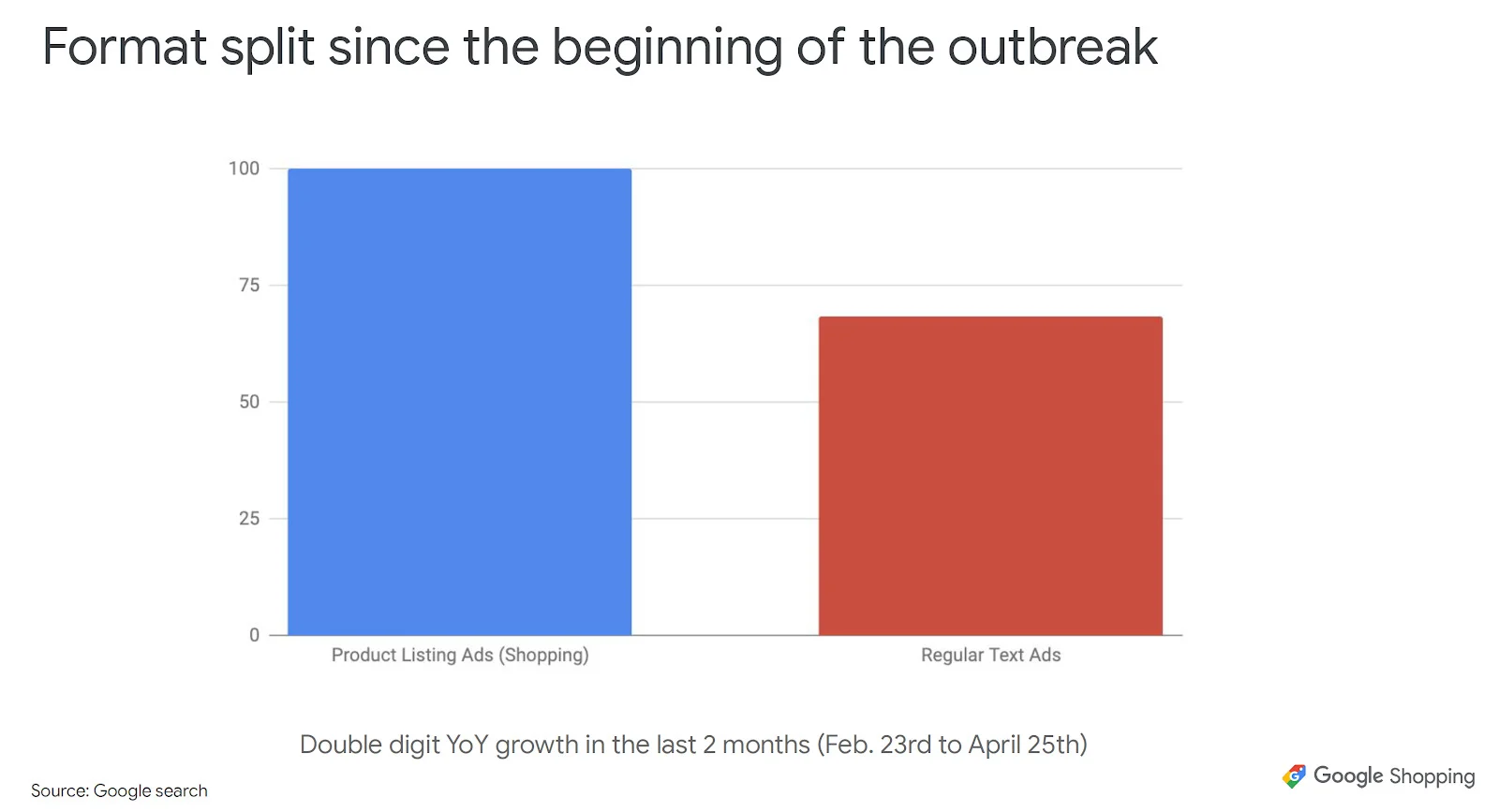
If you aren’t leveraging them now, then you are losing out on being in front of the virtually endless pool of worthy shoppers out there looking for products on Google Search and various other Google surfaces.
Get started today. You won’t regret it.
Conclusion
You’ve just gotten the crash course on all things Google Shopping, and what is, technically speaking, not Google Shopping.
Is there more to it? More than you can even imagine!
I believe that what we have covered here though not only brings a bit more clarity to the “mystery” that is Google Shopping, but also gives you a leg up in getting started.
Go forth with this knowledge and start your Google Shopping journey today.
Have questions? Need help? Don’t hesitate to tag me in the BigCommerce Community Group on Facebook!

Anthony Capetola is the Chief Marketing Officer for Sales & Orders, Marketing Software Built for Ecommerce. A veteran of the digital marketing industry, Anthony started out as a content developer/ghostwriter, moved on to build and manage successful SEM and Social PPC campaigns for hundreds of small to large-sized businesses in various industry verticals, and now heads up the entirety of inbound and customer marketing efforts for Sales & Orders.


